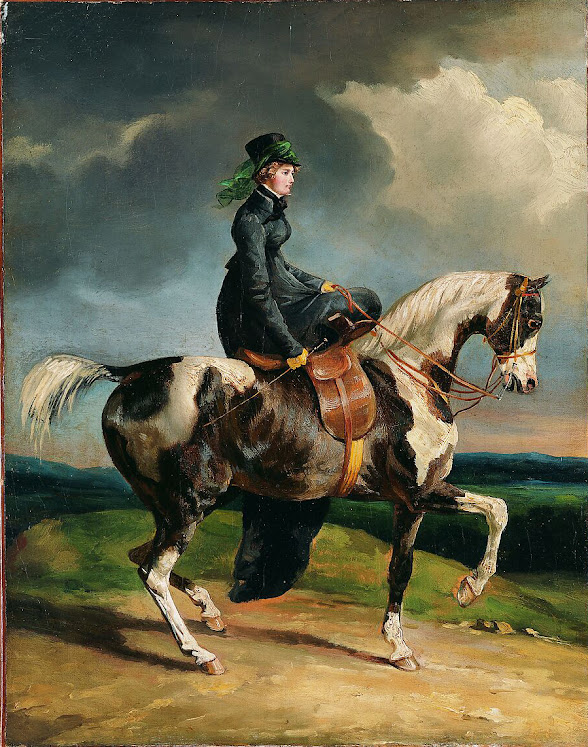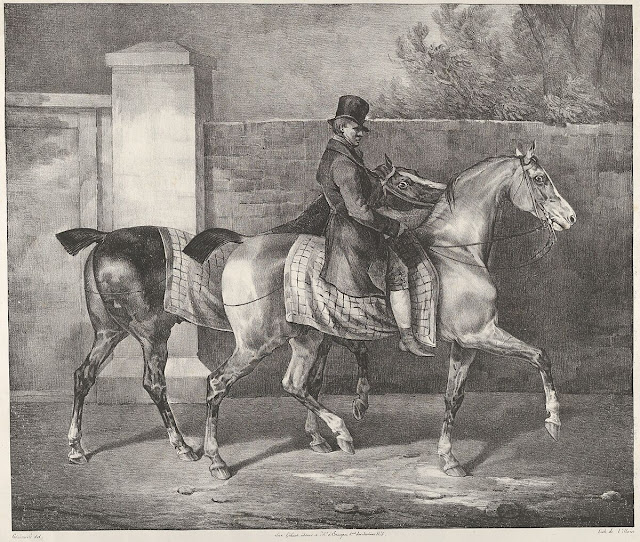 |
| Théodore Géricault by Louis Alexis Jamar oil on canvas |
Jean-Louis-André-Théodore Géricault is now identified as a pioneer of Romanticism in French painting. He loved horses, and dramatic images of rearing horses feature in his work. He was born at Rouen, and from 1808 trained in Paris with Carle Vernet. But after two years he left Vernet - saying 'One of my horses would have devoured six of his' - to go to the Neo-classican painter Pierre Guérin, with whom his friend Delacroix later studied.
Géricault was influenced by the military subjects of Baron Gros and by works in the Louvre, notably those by Rubens and Renaissance Venetian painters. A visit to Italy in 1816-7 intensified Géricault's appreciation of Michelangelo. On his return to Paris he painted his most famous work, 'The Raft of the Medusa' (Paris, The Louvre), a scene of modern drama on a vast scale and executed in the heroic manner, which he exhibited at the Salon of 1819.
An admirer of English art, like Delacroix, he visited England in 1820-1, returning in a state of poor health. From his last years date an exceptional series of portraits, commissioned by a friend, of the inmates of a lunatic asylum.
For earlier works see parts 1 - 3 also. This is part 4 of a 7-part series on the works of Théodore Géricault:
 |
| 1820 The Sleeping Fishmonger lithograph in black on light grey wove paper 21.6 x 29.2 cm |
 |
| 1820 The Infidel lithograph on wove paper 14.8 x 21.2 cm (image) National Gallery of Art, Washington, DC |
 |
| 1820 (or after) Horsewoman oil on canvas 44.5 x 34.9 cm Metropolitan Museum of Art, New York |
 |
| 1820 Groom Mounted on a Carriage-Horse lithograph on cream wove paper 19.7 x 29.2 cm National Gallery of Art, Washington, DC |
 |
| 1820-21 The Coal Wagon, or Le Chariot, Route de Londres watercolour 21.7 x 17.7 cm The British Museum, London |
 |
| 1820-21 Sketches of Draft Horses graphite and brown ink on cream modern laid paper 21.2 x 27.2 cm Harvard Art Museums / Fogg Museums, Cambridge, MA |
 |
| 1820-21 Mounted horse race (medium not given) 29 x 41 cm Louvre, Paris |
 |
| 1820-21 Groom and Horses watercolour over graphite on cream wove paper 29.3 x 37.4 cm Harvard Art Museums / Fogg Museums, Cambridge, MA |
 |
| 1820-21 English Horse Guard watercolour and gouache over graphite on brown wove paper 23.4 x 29.6 cm Harvard Art Museums / Fogg Museums, Cambridge, MA |
 |
| c1820-21 Studies of a cat Graphite with touches of black chalk on tan wove paper 32.2 x 40.3 cm Harvard Art Museums / Fogg Museums, Cambridge, MA |
 |
| 1820-22 Two Draft Horses with a sleeping driver brush and brown and grey wash, over graphite 29.9 x 38.2 cm Metropolitan Museum of Art, New York |
 |
| Title page: Watering Trough lithograph 34.1 x 28.5 cm |
 |
| c1820 Fighting Horses watercolour over graphite on ivory wove paper 21.7 x 29.4 cm (sheet) The Cleveland Museum of Art, Ohio |
 |
| 1820 The Giaour lithograph on chine collé 15 x 21.4 cm |
 |
| 1821 Horses going to a Fair lithograph 32.4 x 43.5 cm (sheet) |
 |
| 1821 An Arabian Horse lithograph 37.1 x 54.5 cm (cropped in here) |
 |
| 1822 Egyptian Mare lithograph 18.1 x 23.5 cm (image) The Cleveland Museum of Art, Ohio |
 |
| 1822 Cart horse out of the stringers Lithograph (size not given) The Cleveland Museum of Art, Ohio |
 |
| 1822 Boy feeding a Cart Horse from a nose bag lithograph 41.7 x 33.1 cm (plate) |
 |
| 1822 Black horse tethered in a stable lithograph 32.8 x 40.4 cm |
 |
| 1822 Auvergne horses lithograph 19 x 23.2 cm The Cleveland Museum of Art, Ohio |
 |
| 1822 Arab horse lithograph (size not given) The Cleveland Museum of Art, Ohio |
 |
| 1822 Horses of Auvergne lithograph 19.4 x 23.3 cm (plate) |
 |
| 1822 Horses driven to a fair lithograph 24.9 x 35.1 cm (plate) |
 |
| 1822 Horse from the Caen Plain lithograph 19.1 x 22.7 cm (image) The Cleveland Museum of Art, Ohio |
 |
| 1822 Horse from Hanover lithograph (size not given) The Cleveland Museum of Art, Ohio |
 |
| 1822 The Flemish farrier Lithograph 24.3 x 32.2 cm (plate) |
 |
| 1822 The English blacksmith lithograph 28.1 x 36.6 cm (plate) |
 |
| 1822 Old horse at an Inn door lithograph 25.6 x 38.3 cm |
 |
| 1822 Mecklembourg horse lithograph on wove paper 18.8 x 23.5 cm (image) |
 |
| 1822 Lara wounded lithograph (size not given) The Cleveland Museum of Art, Ohio |
 |
| 1822 Horses of the Ardennes lithograph on wove paper 15.7 x 22.7 cm (image) |
 |
| 1822 Two Horses exercised by a Jockey lithograph 32.5 x 38.5 cm (plate)) |
 |
| 1822 Two Dappled-Grey horses being exercised lithograph 28.4 x 42 cm (plate) |
 |
| 1822 The Plastermaker's horse lithograph 25,6 x 31.2 cm (plate) |
 |
| 1822 The French Blacksmith lithograph (size not given) The Cleveland Museum of Art, Ohio |

No comments:
Post a Comment
Note: only a member of this blog may post a comment.